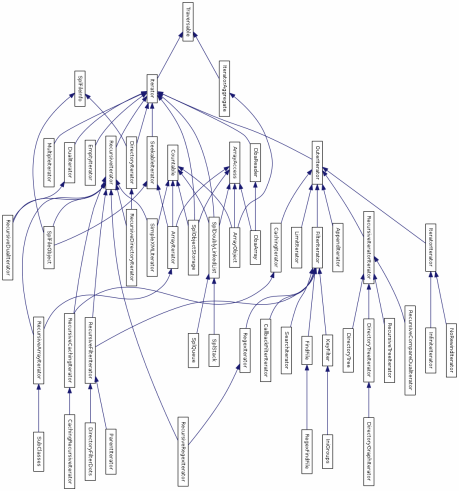Exploring SPL : An Overview of the Iterator and IteratorAgreggate Interface January 23, 2013
Posted by Tournas Dimitrios in PHP.trackback
My previous article (introduction to Iterators) made a short introduction about Iterators and the basic concepts of their functionality . This article , and all articles that will follow , will present practical examples as an attempt to emphasize specific features of SPL’s Iterators . Usually Iterators transform “simple objects” (arrays or instantiated Classes) into “looping structures” with enhanced functionality , other times , Iterators replace standard loop tasks (foreach) with its own looping capabilities (exaggerating somehow … , creating loops on steroids ) . SPL’s “Iterator part” (my definition) has a hierarchical structure of Interfaces and Classes . Knowing the general characteristics of each “component” on the aforementioned hierarchy is crucial , as it will determine which component is best suited for our application . The graph that follows presents the hierarchical “relationship” of all components that constitute SPLs Iterator puzzle .
This article is an overview of the Iterator and IteratorAgreggate Interface . The best approach (IMO) to describe their functionality is by using practical examples , notice through , my attempt is to demystify the basic concepts by using simplified examples . The benefits that might be gained from these techniques may not be obvious at first view , but on production (with large data-sets) , they can boost the performance of an application .
By observing the above graph , one thing is immediately evident , all Classes (and four Interfaces — Countable , OuterIterator , RecursiveIterator , SeekableIterator –) inherit their features from Iterator and IteratorAgreggate Interface . The only exception to this , a stand-alone Class (SplInfo) , which is used as a basis for other Classes (SplObject and DirectoryIterator) . Classes derived from SplInfo though , inherit from Iterator all its features . Traversable Interface is the root of SPL’s Iterator puzzle , its an internal-only Abstraction Interface , so trying to implement it in “userland” Classes will simply result in an error . We can only implement Iterator or IteratorAggregate Interface into our code .
Iterator Interface :
Any Class that implements the Iterator Interface (and of course , defines the five functions — current , key , rewind , valid and next — ) can be used in loops and its objects are called Iterators . Actually the whole subject has been explained on my previous article , lets present the code ones again :
<!--?<span class="hiddenSpellError" pre=""-->php
/**
* Created by Tournas Dimitrios
* Date: 1/20/13
* Time: 5:16 PM
*/
// Iterator
class myIterator implements Iterator {
private $_position = 0;
private $_elements = array() ;
function __construct($elements) {
$this->_elements = $elements ;
$this->_position = 0;
echo 'constructor initiated <br>' ;
}
function rewind() {
echo __METHOD__;
$this->_position = 0;
echo '<br>' ;
}
function current() {
echo __METHOD__;
return $this->_elements[$this->_position];
}
function key() {
echo '<br>' ;
echo __METHOD__ ;
return $this->_position;
}
function next() {
echo __METHOD__;
++$this->_position;
echo '<br>' ;
}
function valid() {
echo __METHOD__;
echo '<br>' ;
return isset($this->_elements[$this->_position]);
}
}
$elements = array(
"firstelement",
"secondelement",
"lastelement",
);
$it = new myIterator($elements) ;
echo '========== Using Foreach-Loop ===========
' ;
foreach($it as $key => $value) {
echo '------> ' , $key , ' : ' , $value . '<br>' ;
echo '<br>----- STARTING NEXT LOOP -------<br>' ;
}
echo '========== Using For-Loop ===========<br>' ;
for ( $it->rewind(); $it->valid(); $it->next() ) {
$curent = $it->current() ;
$key = $it->key() ;
}
As seen on the graph , many pre-build Classes implement this Interface and are ready for use (no need to redefine the five functions) . Of course , nothing prevents us to write our own custom Class and to implement Iterator’s functionality in a way that suits our needs .
IteratorAggregate Interface :
This Interface is used to offload iteration tasks into another Class . It let us reuse common Iteration from an external Class (instead of repeatedly implementing the same code inside each iterable Class) .
<?php
/**
* Created by Tournas Dimitrios
* Date: 1/22/13
* Time: 21:44 PM
*/
class MyElements implements IteratorAggregate
{
private $_items ;
private $_count ;
function __construct() {
$this->_count = 0 ;
$this->_items = array() ;
}
// Required definition of interface IteratorAggregate
public function getIterator() {
return new ArrayIterator($this->_items);
}
public function add($value) {
$this->_items[$this->_count++] = $value;
return $this ;
}
}
$elements = new MyElements();
$elements->add('firstelement')
->add('secondelement')
->add('thirdelement')
->add('lastelement');
foreach ($elements as $key => $val) {
echo "My elements are : [$key -> $val]<br>";
}
To implement the IteratorAggregate Interface into a Class , we must define a “getIterator()” function . This function must return an Iterator object , as I’m using an oversimplified example , my example just returns a build-in ArrayIterator Class (in production code we would actually return a custom Iterator object) . Keep in mind , IteratorAggregate has no build-in Iterator functionality , its task is just to return an Iterator . Thanks to polymorphism , any Class that implements the Iteration Interface can be used as a returning object from the getIterator() function (as seen on the graph , there are many ) .


 Linux >>>
Linux >>> 

Comments»
No comments yet — be the first.